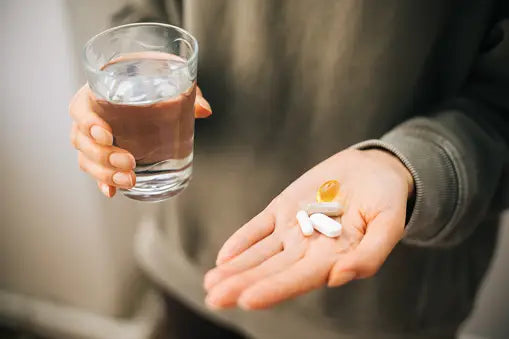

What Is Juggernaut® X
Table of Contents
The ultimate pre-workout supplement to support workout intensity, stamina and muscular endurance, strength, and massive muscle pumps. We’ve taken our original Juggernaut and reformulated Juggernaut X into our strongest and most powerful pre-workout we have to offer! With included ingredients such as Citrulline, Agmatine Sulfate, Malic Acid, Caffeine, Tyrosine and our unique formula combines all of the necessary ingredients to ensure you receive the boost needed for that optimal training session desired by many athletes and bodybuilders.
What’s In Juggernaut X
- Citrulline
- Agmatine
- Creapure® Creatine
- Carnosyn Beta-Alanine
- Caffeine
- L-Tyrosine
- Malic Acid
- Ascorbic Acid

Citrulline (8 grams)
Citrulline is a non-essential amino acid that plays a vital role in nitrogen balance and numerous metabolic processes. It is primarily synthesized from glutamine in the intestines but is also found naturally in trace amounts in a variety of foods. Citrulline is included in this formula as a novel way to support arginine as well as nitric oxide (NO). In the cells that line the blood vessels (endothelium cells), nitric oxide production causes vasodilation (opening of the vessels). NO is involved in the overall regulation of systemic vascular resistance, where it inhibits the adherence of cells and foreign substances to the blood vessel walls and helps suppress the overgrowth of smooth muscle cells in the lining of the vessels.
In addition to its potential benefit on arginine and NO production, citrulline may be an effective method of maintaining plasma volume (Note: Plasma volume is the measure of the volume of plasma in the blood. Plasma is the liquid portion of blood consisting of various inorganic salts, such as sodium, potassium, calcium, and proteins; the solid portion of blood is composed of cells.).
The use of citrulline is a much more effective stimulator of NO than arginine. In fact, several studies have reported that the ingestion of L-citrulline is more effective than L-arginine ingestion in supporting plasma L-arginine concentration. Specifically, it has been demonstrated that acute ingestion of 3–6 g of L-citrulline results in a doubling of plasma L-arginine concentration in healthy humans. These values are 30% higher than would be attained following ingestion of a similar dose of L-arginine.
Recent studies have found that short-term L-citrulline, but not L-arginine, supplementation can also support blood pressure, VO2 kinetics and exercise performance in healthy adults. This suggests that during high-intensity exercise, L-citrulline supplementation may support the total amount of work performed.*
In more recent studies, it was found that 8 grams of citrulline consumed each day supported leg performance in experienced weight lifters. The researchers conducting this particular study had experienced weight lifters consume citrulline before performing submaximal repeated bouts of multiple lower-body resistance exercise.*
The exercise protocol resulted in a significant decrease in the number of repetitions in response to exercise. However, subjects in the citrulline group performed a significantly higher number of repetitions compared with the placebo group.*
In conclusion, these results suggest that citrulline supplementation may be beneficial in supporting exercise performance during lower-body multiple-bout resistance exercise in advanced resistance-trained men.*
Agmatine (1 gram)
Agmatine is a unique supplement capable of providing enormous benefits to anyone looking to support their mental and physical performance. Agmatine biosynthesis by arginine decarboxylation is well positioned to compete with the principal arginine-dependent pathways, namely: Nitrogen metabolism (urea cycle), polyamine and NO synthesis, as well as protein synthesis. Studies show that agmatine has cardio-protective and supportive benefits through (among other actions) its impact on nitric oxide regulation, neuroprotective benefits through its role as a modulator and supportive agent for neurotransmitters, and cognitive/mood-supporting benefits through its combined influences on nitric oxide synthesis and neurotransmitter modulation.*
Agmatine is a neurotransmitter that works in a variety of ways to support mental and physical health. It not only supports the pump that will flood the targeted muscle with blood, and essentially, nutrients, but it may also assists with insulin sensitivity and glucose metabolism, and may support secretion of beta-endorphin (which is essentially a ‘feel-good’ neurotransmitter).*
Creatine (2.5 grams)
First discovered in 1832, creatine is an amino acid-like compound made in the liver, kidneys and pancreas from arginine, glycine, and methionine. Dietary sources of creatine include meat, fish, and poultry. Adults and teenagers who regularly consume these foods typically eat 1-2 grams of creatine per day, an amount that is roughly equal to the body’s rate of creatine degradation. In a normal, healthy adult male, 95% of creatine stores are found in skeletal muscle, while the remaining 5% is found in the heart, brain, eyes, kidneys, and testes. Since 1992, over 300 research papers have been published on the effects of creatine as a muscle builder and performance enhancer. In general, the majority (~ 65-70%) of these clinical trials have found beneficial effects from creatine monohydrate supplementation, particularly during short, repeated bursts of high-intensity activity.*
Although responses are variable from person to person, subjects ingesting creatine average a 2-5-pound greater gain in muscle mass, and 5-15% greater increases in muscle strength and power compared to control (or placebo) subjects. Moreover, vegetarians who consume no animal products are likely to experience even greater benefits from creatine use.*
A useful analogy is that creatine is to the strength/power and repeated sprint athlete what carbohydrate is to the endurance athlete. In other words, the physiological functions of creatine support energy production during intense, repeated muscular activity. More specifically, following its transport and uptake into muscle, creatine is thought to serve at least four vital functions:
- 1) it serves as an energy capacitor, storing energy which can be used to regenerate adenosine triphosphate (ATP);
- 2) it supports the capacity for energy transfer between the mitochondria and muscle fibers;
- 3) it serves as a buffer against intracellular acidosis during exercise; and
- 4) it activates glycogenolysis (glycogen breakdown) during exercise.
Collectively, these effects allow athletes to perform at higher levels during training, ultimately supporting greater increases in muscle mass, strength, power, and high-intensity muscle endurance.* Recent studies have also focused on the potential benefits of creatine use on certain neurological and cardiovascular diseases.
Initial recommendations for creatine use stemmed from early research using 5-7 days of “loading” with 20-30 grams per day (divided into 4-6 equal, 5-gram doses). Based on new research, refinements have been made to this strategy, and now many athletes consume only one, 5-gram dose approximately 60 minutes before, or immediately after training (exercise is known to support creatine uptake by about 10%).
Although still somewhat speculative, creatine cycling (i.e., 4-weeks of use followed by a 4-week break) is supported by studies showing that once muscle stores of creatine are full, they can remain elevated for an additional 4-5 weeks without supplementing at all. In normal, healthy men and women, daily supplementation with 3-5 grams per day of creatine appears to pose no adverse health risks. Long-term use of higher doses (≥ 10 g/day) is not recommended because research on this type of creatine usage is not yet available. Thus, creatine loading is unnecessary. Daily doses of 3-5 grams, depending on bodyweight, is sufficient to support intramuscular stores of creatine and support muscle mass and performance within 30-days.
Creatine may also assist muscle mass by reducing myostatin levels. In a study in the Journal of Molecular and Cellular Endocrinology, researchers examined how creatine impacted myostatin levels in resistance-trained men. In a double-blind design, 27 healthy male subjects were assigned to resistance training and creatine supplementation groups. Amazingly, the study found that creatine supplementation added to a resistance-training program amplified the training-induced decrease in serum levels of myostatin, increasing the effects of exercise on muscle strength and mass.
Beta-Alanine (2.5 grams)
Beta-alanine is an amino acid that, with the help of another amino acid called histidine, helps form a compound called carnosine within the muscle. Carnosine, in turn, is one of the most powerful pH (acid) buffers known to operate in muscle during intense exercise. Over the past fourteen years, research from five countries (Japan, the United Kingdom, Korea, Russia, and the United States) have been accumulating research on the potential benefits of beta-alanine supplementation in humans.
To put it simply, if high-intensity workouts are your thing, beta-alanine will help you reach new levels of performance. For example, a placebo-controlled double-blind study of 33 men was recently undertaken at The College of New Jersey. After being placed into a creatine only (10.5 grams/day), creatine + beta alanine (10.5 grams creatine + 3.2 grams/day beta alanine), or placebo (10.5 grams/day of dextrose) group, subjects underwent 10-weeks of resistance training.
Researchers reported that subjects in the creatine + beta-alanine group gained significantly more lean mass (~ 4 lbs) and lost more body fat than subjects in the other two groups. Also, fatigue rates during training were lowest, and training volume was highest, respectively, in the creatine + beta-alanine group.
In another study that assessed the effects of beta-alanine supplementation in humans, 51 men supplemented daily with 3.2 grams of beta-alanine for 28 days. The supplement was divided into four, 800 mg doses per day for six consecutive days, followed by two, 1.6 g doses for the next 22 days. Results indicated that beta-alanine supplementation delayed the onset of fatigue (and thus supported performance) by 14.5%.
In contrast to the above study, there was no additive effect when beta-alanine was combined with daily doses of creatine monohydrate. Finally, a recent study examined the effects of taking beta-alanine for 4-weeks vs. 10-weeks on cycling performance. 25 healthy men were supplemented with either a placebo or 4 to 6 grams per day of beta-alanine.
After 4-weeks, subjects taking beta-alanine had significant increases in leg muscle carnosine levels, and by 10-weeks carnosine levels had almost doubled compared to baseline. Regarding performance, beta-alanine increased total work capacity by 13% after 4-weeks, and 16% after 10-weeks. In contrast, no changes occurred in the placebo group. By supporting the buffering potential of muscle, beta-alanine assists training intensity and volume, thus potentiating the beneficial effects of exercise training on body composition.
Carnosine (also known as beta-alanyl-L-histidine) is a molecule made up of two amino acids, alanine and histidine. Carnosine helps to buffer hydrogen ions in muscles, therefore, increases repetitions to failure and enhances muscular performance. Beta-alanine is the limiting amino acid for carnosine synthesis, and beta-alanine supplements have been shown to increase muscle levels of carnosine. In fact, only beta-alanine supplements, rather than carnosine supplements, have been tested on athletic performance in human subjects. Thus there is no advantage to ingesting carnosine. Having low histidine levels can lower carnosine levels.
Caffeine (350 mg)
Caffeine is the most widely consumed psychoactive substance in the western world. In addition to being a CNS stimulant, it has a variety of peripheral effects relating to muscle contraction, diuresis, gastric secretion, and lipolysis. The average US citizen consumes 206 mg of caffeine daily (the equivalent of about two cups of coffee), and 10% of the adult population ingests more than 1000 mg of caffeine daily. Chemically, caffeine (1,3,7-trimethylxanthine) is a member of a class of drugs known as methylxanthines.
The primary pharmacological effect of caffeine is a selective antagonism of the adenosine A1 and A2A receptors. Adenosine is a cellular constituent that modulates the release and activity of a variety of neurotransmitters, including norepinephrine, acetylcholine, dopamine, and GABA. It primarily inhibits the release of excitatory neurotransmitters, so increased concentrations of adenosine reduce arousal and suppress spontaneous behavioral activity.
Adenosine concentrations slowly increase during wakefulness, so adenosine antagonism is what causes caffeine’s wake-promoting effect. Other effects of caffeine include inhibition of phosphodiesterase (PDE), GABA-A blockade, and mobilization of intracellular calcium. The relevance of these effects at normal doses is debatable.
The beneficial effect caffeine has on endurance-type exercise is well established, and has been confirmed in a multitude of studies. During submaximal exercise, caffeine in doses of 3-9 mg/kg (200-900 mg) delays fatigue considerably, increasing exercise time by 20-50%, with the 3-6 mg/kg range appearing to be ideal. Lower doses, such as 1.5 mg/kg, appear to offer at least some benefit. The magnitude of the beneficial effect depends on a variety of factors, such as type and intensity of exercise (the greatest effect is seen in exercise lasting 30-120 minutes), previous caffeine use (with greater and longer lasting effects among nonusers), training status, and individual variation.
Although many of these studies are conducted in the fasted state, which does not reflect realistic conditions, the benefit is still seen in studies in which the subjects are well fed. Using caffeine to support endurance performance is also quite safe. Doses as high as 10 mg/kg do not impair thermoregulation during exercise, and exercise prevents the effects caffeine has on diuresis, so hydration status is not compromised.
Caffeine has also been found to increase repetitions to fatigue during resistance exercise. Researchers examined the impact of acute caffeine ingestion on perceptions of muscle pain following a bout of high-intensity, upper-body resistance exercise to failure. Moderately trained males ingested a dose of caffeine (5 mg · kg-1) or placebo in a randomized and counterbalanced order and 1 hour later completed bench press exercise to failure at an intensity of 60% 1 repetition maximum. At the end of the study, caffeine resulted in improved repetitions to failure, greater peak blood lactate, and lower RPE compared to placebo.
Muscle pain perception was also significantly lower in the caffeine condition compared to placebo. Caffeine increased reps to failure by an average of 11.6% on the bench press and 19.1% on the leg press. The results suggest that caffeine ingestion supports muscular strength performance and reduces upper body muscle pain perception immediately following a bout of high-intensity resistance exercise to failure.

L-Tyrosine (1 gram)
The amino acid tyrosine is the precursor to the catecholamine neurotransmitters dopamine and norepinephrine. In fact, the hydroxylation of tyrosine by the enzyme tyrosine hydroxylase is the rate-limiting step in the synthesis of the catecholamines. Increasing tyrosine uptake may positively influence catecholamine-related psychological functioning.
There is evidence that tyrosine may benefit healthy individuals exposed to demanding situational conditions. Some have suggested that inadequate production of these hormones or transmitters could also compromise optimal physical performance. For example, tyrosine administration appears to support cognition and performance in soldiers under stressful conditions.
Malic Acid
Malic Acid is a natural derivative of apple pomace. In human physiology and nutrition, malic acid is a cofactor in the Krebs cycle. Malic acid is a naturally occurring compound that plays a role in the complex process of deriving adenosine triphosphate (ATP; the energy currency that runs the body) from food.
In alternative medicine, malic acid is typically used to support sports performance when taken in supplement form. Proponents claim that malic acid can also support endurance during exercise and help fight off fatigue.
Moreover, malic acid has been shown to support the effects of citrulline.*
As malic acid plays a very significant part in the prevention of oxygen deficiency in muscle tissues, it is believed that supplements of this acid could help support athletic performance by maximizing the production of energy in the body.*
Ascorbic Acid
Vitamin C, or ascorbic acid, is a water-soluble antioxidant vitamin and an essential cofactor for many enzymes. It is found primarily in fruits and vegetables, with a serving containing 20-120 mg, although the amount can be affected by many variables. Despite the high availability of vitamin C from foods, the average daily intake in the US in males and females is 84 mg and 73 mg respectively, while the new RDA is 90 mg and 75 mg daily for men and women.
The biological actions of vitamin C are attributed to its antioxidant properties. In general, oxidative stress occurs in three general classes of biomolecules – lipid, protein, and DNA. Vitamin C has the potential to prevent oxidative stress in all of these areas, although results depend on study design, and a greater effect is seen in situations where health is compromised. Lipid peroxidation occurs when lipids interact with reactive oxygen species (ROS), and these lipid peroxides further react with oxygen to form peroxyl radicals that then result in lipid hydroperoxides. Studies both in vitro and in animals have found vitamin C to reduce lipid peroxidation. Vitamin C can help prevent the formation of reactive nitrogen species, and vitamin C has also been found to reduce DNA oxidation from a variety of causes both in vitro and in vivo.*
Exercise causes a significant increase in the production of free radicals, which can originate from the mitochondria, the capillary endothelium, and oxidative bursts from inflammatory cells. Whole body oxygen consumption dramatically increases during exercise, which leads to a greater production of oxygen radicals, and can challenge the natural antioxidant defense system.
Although there is conflicting research, many studies have found that vitamin C supplementation decreases exercise-induced oxidative stress. One study also reported a decrease in muscle soreness after unaccustomed exercise with vitamin C supplementation.*
A final effect that has been noted, and replicated, is a reduction of serum cortisol from vitamin C supplementation in ultramarathon runners.*
The average body pool of vitamin C is 1500 mg, with a turnover of 3-4% daily, which suggests that 60 mg daily is needed to maintain stores. The RDA was recently raised to 75 mg, based on variability in absorption and other factors. 20-30% of the US population does not meet the RDA for vitamin C.*
Of course; there is a large amount of evidence that the required dose is far from optimal, and, for this reason, there is much literature devoted to optimal vitamin C intake. It has been estimated that our Paleolithic ancestors consumed approximately 4 g daily.
Estimates for optimal dosage fall in the 200-1000 mg range, although some researchers argue that the amount is as high as 2-3 g. There is no solid scientific basis for doses higher than this.
Currently, the ideal daily dosage of vitamin C appears to be in the range of 500-1500 mg, depending on circumstances. The higher amount should be used in circumstances of increased oxidative stress, such as intense training or sickness. Given the studies finding no benefit or increase in tissue levels from higher doses and the possibilities of stone formation and iron overload, there is little reason to exceed 2 g daily.
Intense exercising spikes cortisol levels that can have a negative impact on testosterone levels over time and lead to long-term overtraining and suppressed increases in size and strength, which is something most athletes want to avoid. As vitamin C’s ability to suppress cortisol production is well documented, many athletes will take some vitamin C (usually 1g) post workout.
Peer-reviewed research studies have found that Vitamin C inhibits cortisol release by as much as 30%. In one study, researchers examined the effect of 2 weeks of supplementation with vitamin C on cortisol, adrenocorticotrophic hormone, interleukin-6, oxidative stress and neutrophil responses to a single bout of endurance exercise. Nine healthy endurance-trained males exercised for 2.5 hours at 60% VO2max after two weeks of placebo or Vitamin C (1,000 mg day) supplementation.
All participants completed both trials utilizing a randomized crossover design with a minimum 14 day washout period between trials. At the end of the 2 week study, men who consumed 1 gram of vitamin C a day for two weeks had significantly lower cortisol after a 2.5-hour endurance run than a placebo group. Vitamin C is just about the cheapest supplement that you can consume that will help control cortisol levels and reduce free radical damage.

















